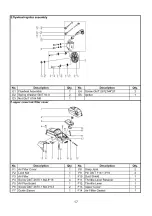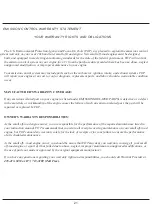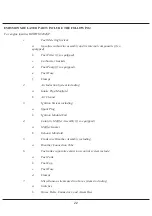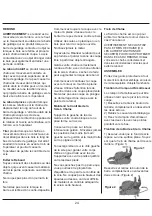
9
4) Clean the oil holes and bar
groove.
5) If the bar is burred, remove the
burs with a flat file.
6) If the rail top is uneven, use a flat
file to make the sides and edges
square again.
Replace the guide bar when the
groove is worn, the bar is bent or
cracked, or when excessive heating
or burring occurs. If the bar needs
replacing, only use the guide bar
specified in the parts list or on the
chain saw.
Oil passages
The oil passages should be cleaned
to allow proper lubrication of the bar
and chain.
The condition of the passages can
be checked. If they are clear, the
chain will automatically send off a
spray of oil within seconds of starting
the saw because it is equipped with
an automatic oiler system.
Automatic chain lubrication
The chain is equipped with an
automatic oil system with a toothed
wheel drive. It will automatically
supply the bar and chain with the
right amount of oil. When the engine
is accelerated, the oil will flow
through the bar more quickly.
The lubrication system has been set
at the factory. The screw for
adjusting the lubrication is located on
the underside of the chainsaw. By
turning the screw counterclockwise,
it will increase the lubrication and
turning it clockwise will decrease the
lubrication.
To check the lubrication, hold the
chain saw over a piece of paper and
run it at full speed for a few seconds.
The amount of oil on the paper will
determine if the lubrication needs to
be increased or not.
Chain Maintenance
Sharpening
Chain sharpening requires special
tools to ensure that the cutters are
sharpened to the proper angle and
depth. We recommend you allow a
professional chain sharpener to
sharpen your chain.
Breaking in a new chain
A new chain and bar will need
adjusting after as few as 5 cuts. This
is normal during the break-in period
and the interval between future
adjustments will begin to lengthen.
Chain lubrication
Make sure the oil tank is filled with
the appropriate oil to lubricate the
chain. Running the saw with low or
no oil will cause damage to the
chain and the saw, causing
overheating and excessive wear.
STORAGE
If a chainsaw is going to be in
storage for longer than 30 days,
follow these instructions.
Storing a chainsaw
1) Remove the fuel tank slowly in
order to release any pressure in the
tank. Carefully drain the fuel from
the tank.
2) To remove all of the fuel from the
carburetor, start the engine and let it
run until the saw stops.
3) Allow the engine to cool
completely.
4) Remove the spark plug.
5) Pour 1 teaspoon of 2-cycle oil into
the combustion chamber. Slowly pull
the starter rope a few times in order
to coat the internal parts. Replace
spark plug.
Note:
Store the unit away from
water, sources of flame and sparks
and in a cool, dry location.
Preparation to use saw again
1) Remove the spark plug.
2) Pull the starter rope briefly to
clear excess oil from the
combustion chamber.
3) Clean the spark plug and check
the electrode gap.
4) Replace the spark plug.
5) Fill the fuel tank with the proper
fuel mixture.
6) Check oil levels.
Summary of Contents for 20120
Page 13: ...13 Parts List...
Page 14: ...14...
Page 15: ...15...
Page 16: ...16...
Page 17: ...17...
Page 18: ...18...
Page 19: ...19...










































